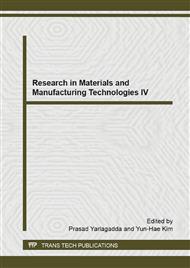[1]
E. Habibi, and B. Hollifield, Alarm systems greatly affect offshore facilities amid high oil process, World Oil Magazine, Vol. 227, No. 9, (2006).
Google Scholar
[2]
T. Stauffer, N. P. Sands, and D. G. Dunn, Alarm Management and ISA-18 – A Journey, Not A Destination, Texas A&M Instrumentation Symposium, (2010).
Google Scholar
[3]
V. Venkatasubramanian, R. Rengaswamy, K. Yin, and S. N. Kavuri, A review of process fault detection and diagnosis Part I: Quantitative model-based methods, Computers and Chemical Engineering, pp.293-311, (2003).
DOI: 10.1016/s0098-1354(02)00160-6
Google Scholar
[4]
ANSI/ISA-18. 00. 02, Management of Alarm Systems for the Process Industries, ISA, Research Triangle Park, (2009).
Google Scholar
[5]
D. H. Rothenberg, Alarm Management for Process Control – A Best Practice Guide for Design, Implementation, and Use of Industrial Alarm Systems, Momentum Press, New York, (2009).
Google Scholar
[6]
EEMUA, Alarm Systems: A Guide to Design, Management and Procurement, The Engineering Equipment and Materials Users Association, Publication 191, 2nd , London, (2007).
Google Scholar
[7]
J. Koene, and H. Vedam, H., Alarm Management and Rationalization, Third International Conference on Loss Prevention, (2000).
Google Scholar
[8]
W. M. P. Aalst, and A.J.M.M. Weijters, Process mining: a research agenda, Computers in Industry, Vol. 53, pp.231-244, (2004).
DOI: 10.1016/j.compind.2003.10.001
Google Scholar
[9]
S. J. Bailey, From desktop to plant floor, a CRT is the control operators window on the process, Control Engineering, Vol. 31, pp.86-90, (1984).
Google Scholar
[10]
M. Song, C. Günther, and W.M.P. Aalst, Trace clustering in process mining, Proceedings of the 4th Workshop on Business Process Intelligence, Milan, Volume 17, pp.109-120, (2009).
Google Scholar
[11]
Y. Zhang, J. Zhang, J. Ma, and Z. Wang, Z, Fault Detection Based on Data Mining Theory, IEEE International Workshop on Intelligent Systems and Applications, (2009).
DOI: 10.1109/iwisa.2009.5072864
Google Scholar
[12]
W.M.P. Aalst, Process Mining – Discovery, conformance and enhancement of business processes, Springer, (2011).
Google Scholar
[13]
W.M.P. Aalst, H.A. Reijers, A.J.M.M. Weijters, B.F. Dongen, A.K.A. Medeiros, M. Song, and H.M.W. Verbeek, Business Process Mining: An Industrial Application, Journal Information Systems, Vol. 32, Issue 5, UK, (2007).
DOI: 10.1016/j.is.2006.05.003
Google Scholar
[14]
A. Rozinat, I. S. M. Jong, C. W. Günther, and W. M. P. Aalst, Process Mining Applied to the Test Process of Wafer Steppers in ASML, IEEE Transactions on Systems, Man, and Cybernetics - Part C: Applications and Reviews, Vol. 39, No. 4, p.474–479, (2009).
DOI: 10.1109/tsmcc.2009.2014169
Google Scholar
[15]
V. Kannan, W. M. P. Aalst, and M. Voorhoeve, Formal Modeling and Analysis by Simulation of Data Paths in Digital Document Printers, Workshop on the Practical Use of Coloured Petri Nets and CPN Tools, Vol. 588 of DAIMI, pp.27-46, Aarhus, Denmark, (2008).
DOI: 10.7146/dpb.v37i588.7188
Google Scholar
[16]
W.M.P. Aalst, M. H. Schonenberg, and M. Song, Time prediction based on process mining, Journal Information Systems, Vol. 36, Issue 2, (2011).
DOI: 10.1016/j.is.2010.09.001
Google Scholar
[17]
B. van Dongen, A. K. de Medeiros, H. Verbeek, A. Weijters, and W. van der Aalst, The ProM framework: A new era in process mining tool support, Application and Theory of Petri Nets, LNCS 3536, 444–454, (2005).
DOI: 10.1007/11494744_25
Google Scholar
[18]
A.K.A. Medeiros, A. Guzzo, G. Greco, W.M.P. Aalst, A.J.M.M. Weijters, B. Dongen, and D. Saccà, Process Mining Based on Clustering: A Quest for Precision, Proceedings of Business Process Management Workshop, Volume 4928, pp.17-29, Brisbane, Australia, (2008).
DOI: 10.1007/978-3-540-78238-4_4
Google Scholar
[19]
G.C. Ruiz and M. Sepúlveda, Discovering potential failures in business processes extending Process Mining techniques. Jornadas Chilenas de Computación, (2011).
Google Scholar
[20]
P. Hornix, Performance Analysis of Business Processes through Process Mining. Master's Thesis, Technische Universiteit Eindhoven, Eindhoven, The Netherlands, (2007).
Google Scholar
[21]
A. Burattin and A. Sperduti, Heuristics Miner for Time Intervals. ESANN 2010 proceedings, European Symposium on Artificial Neural Networks - Computational Intelligence and Machine Learning. Bruges (Belgium), pp.28-30, (2010).
Google Scholar
[22]
M. Jans, N. Lybaert and K. Vanhoof, Internal fraud risk reduction: Results of a data mining case study. International journal of accounting information systems. Elsevier, Vol. 11. 2010, 1, pp.17-41, (2010).
DOI: 10.1016/j.accinf.2009.12.004
Google Scholar
[23]
M.S. Saravanan and R.J. Rama Sree. A Role of Heuristics Miner Algorithm in the Business Process System. International Journal of Computer Technology and Applications, Vol. 2 (2), pp.340-344, (2011).
Google Scholar


